Effects of the Disbursement of EU Cohesion Policy 2014–2020 Funds on Improving the Energy Efficiency of Buildings in Poland and Germany
Abstract
1. Introduction
2. Motivation and Characteristics of Case Studies
2.1. Motivation
2.2. Characteristics of Case Studies
3. Materials and Methods
3.1. Materials
3.2. Research Assumptions and Methodology
3.2.1. Selection of Projects for Analysis
3.2.2. The Selection of the Subject of Analysis
3.2.3. Statistical Analyses
- xij—the observation value;
- xj—the average score in the sample;
- sj—the standard deviation of the sample.
4. Results
4.1. Financing of IEEBs in Poland and Germany

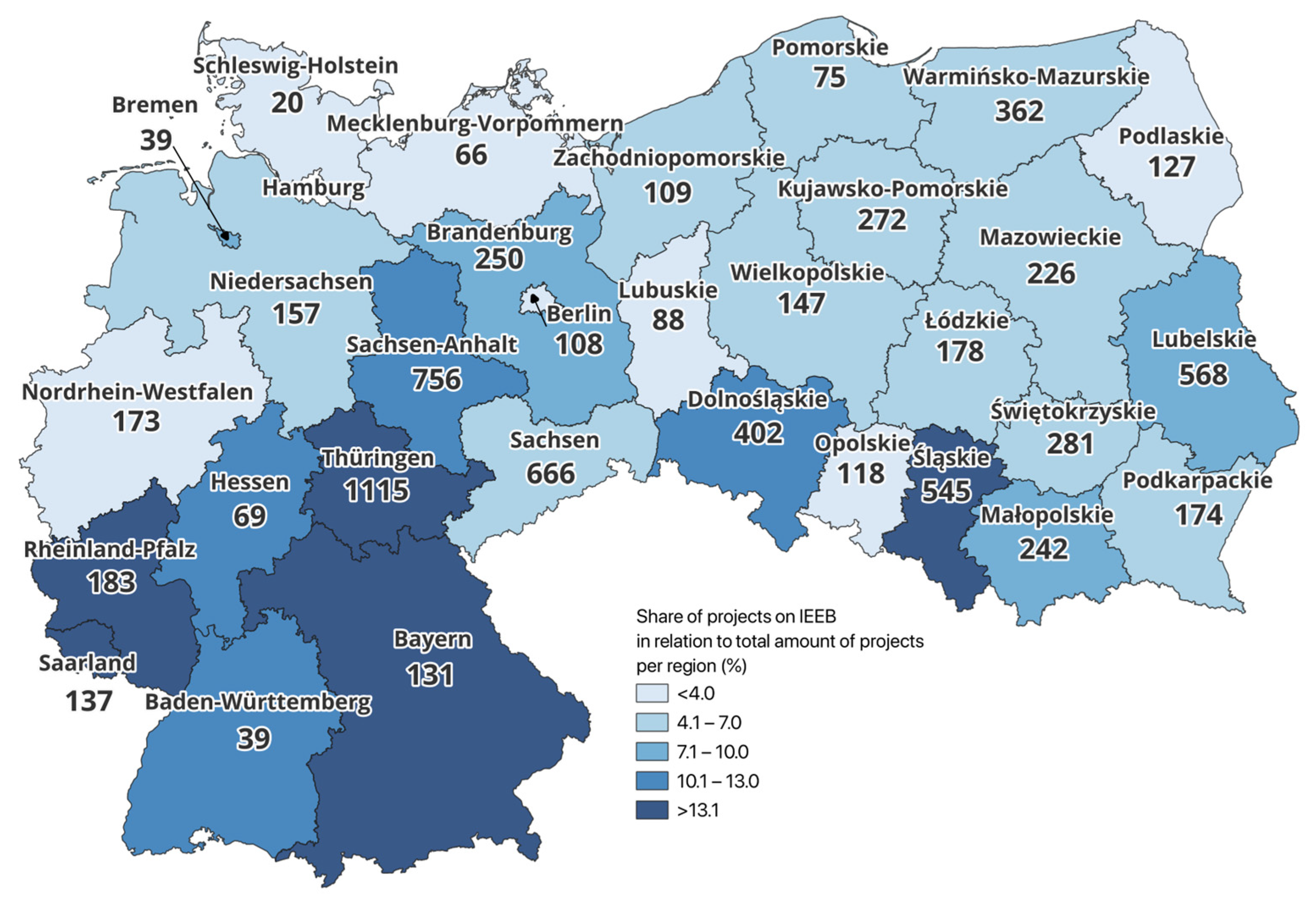
4.2. Type of Beneficiaries
4.2.1. Group 1B
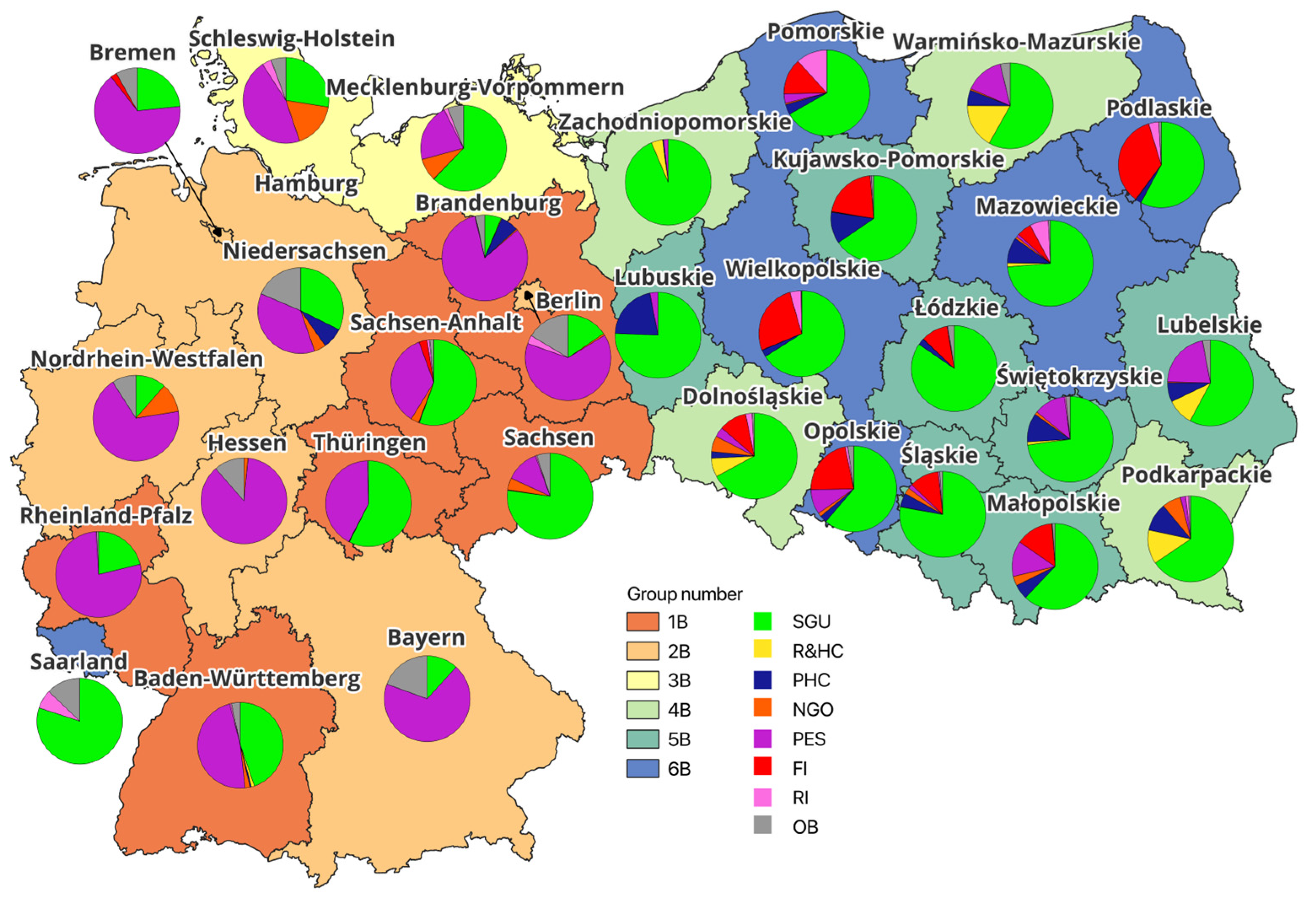
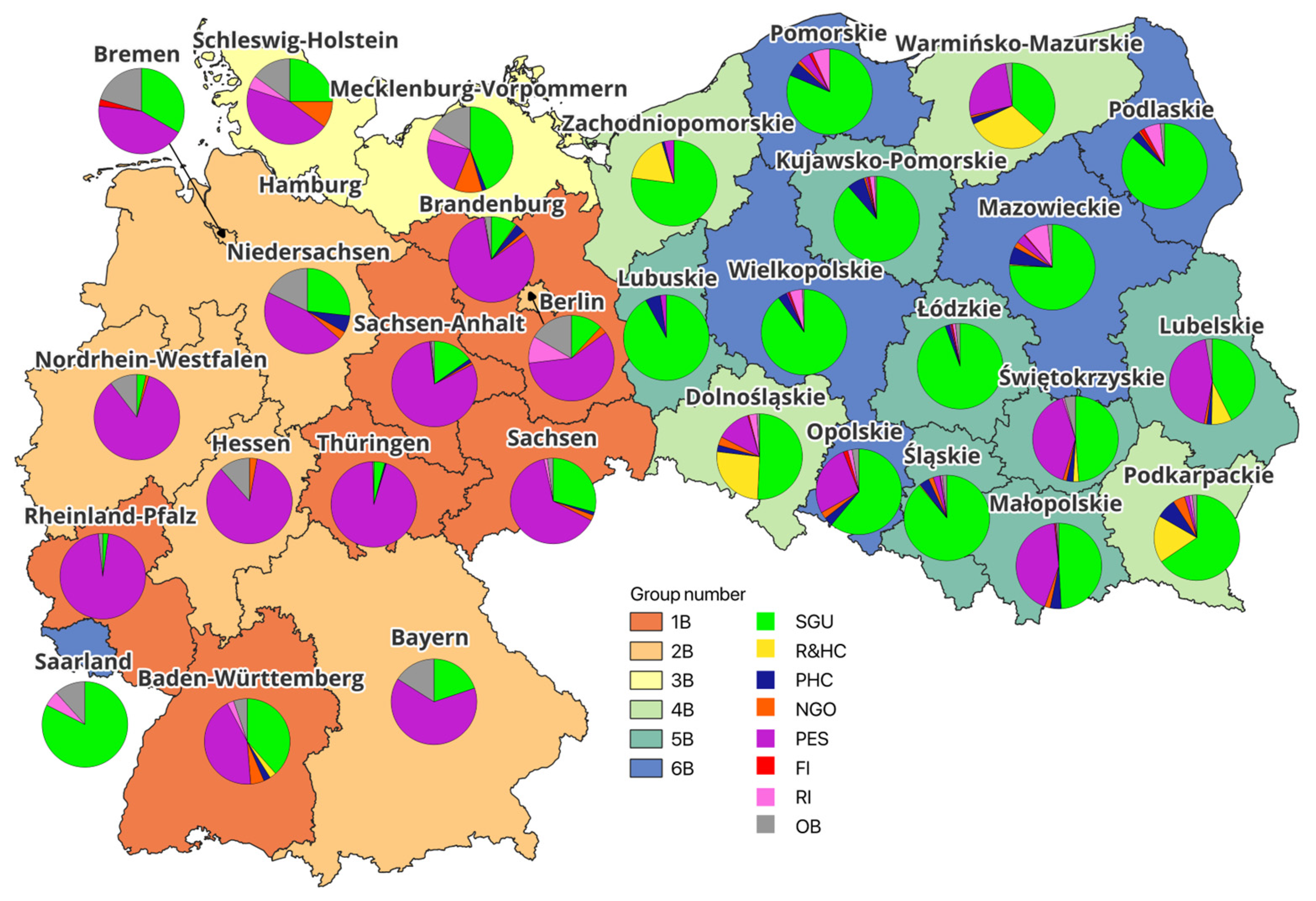
4.2.2. Group 2B
4.2.3. Group 3B
4.2.4. Group 4B
4.2.5. Group 5B
4.2.6. Group 6B
4.3. Investments
4.3.1. Group 1I
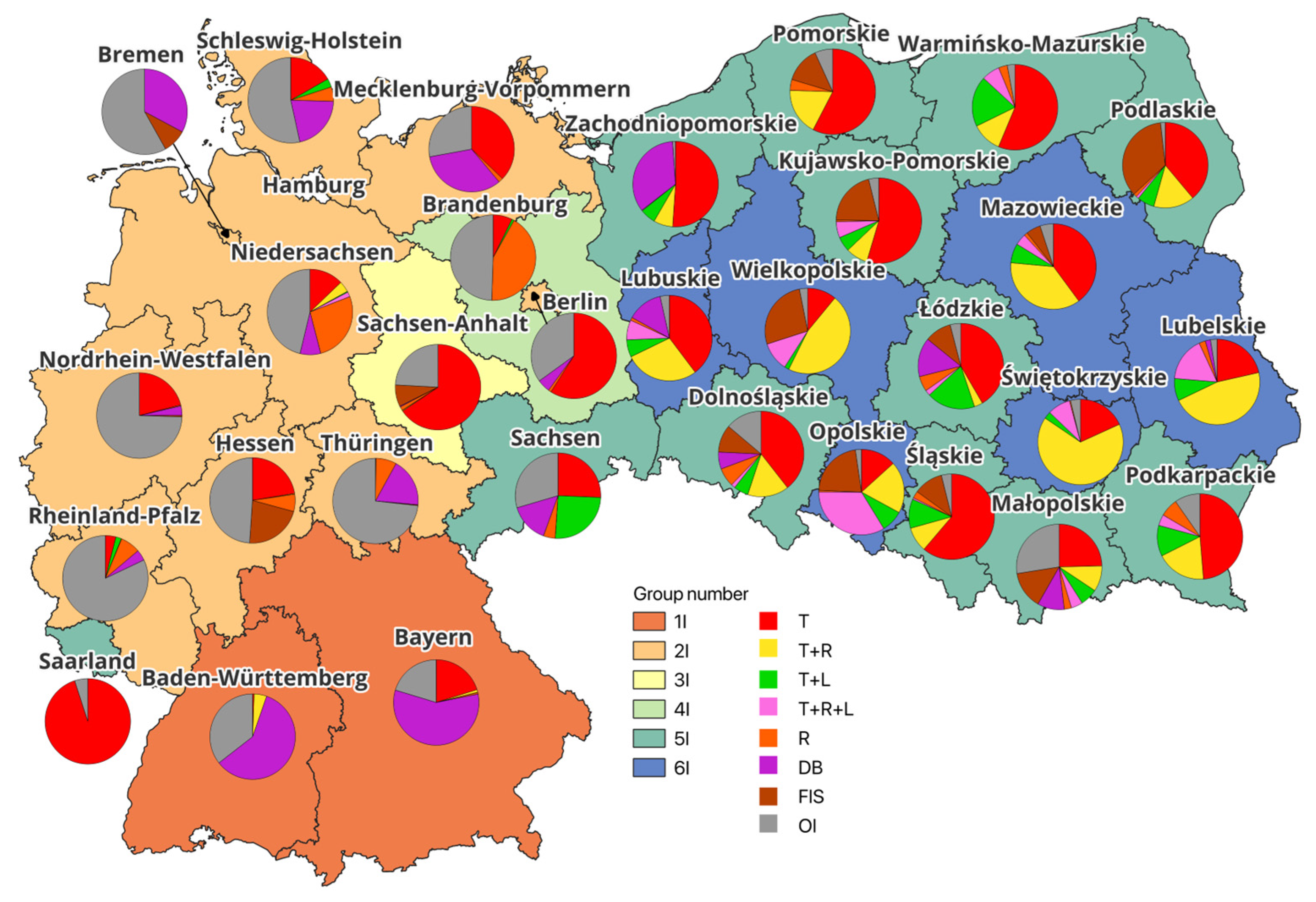

4.3.2. Group 2I
4.3.3. Group 3I
4.3.4. Group 4I
4.3.5. Group 5I
4.3.6. Group 6I
5. Discussion
5.1. How Were IEEB Subsidies Distributed in the Regions?
5.2. Which Groups of Beneficiaries Were Involved in the Disbursement of IEEB Funds?
5.3. Which Investments Were Prioritized?
5.4. Do the Changes in Territorial Affiliation Matter?
6. Conclusions
- (1)
- Support for IEEBs is one of the pillars of the EU’s climate and energy policies, which is reflected both in legislation, strategies, and plans, as well as in the rules for programming the distribution of funds under the EU Cohesion Policy;
- (2)
- A comparison of IEEB allocations revealed a much higher commitment to financing the low-carbon transition of building stocks in Germany (10% of the total ERDF allocation, and 50% allocations under TO4 in OPs) than in Poland (4.5% and 1/3, respectively);
- (3)
- A characteristic feature of Germany is the concentration of funds and projects for IEEBs in the former East German states (more than 60% of the allocation and over 75% of the projects, with as much as 65% in Sachsen-Anhalt, Sachsen, and Thüringen only). In Poland, the allocation in voivodeships was relatively higher and the distribution of funds, more equal (more than EUR 90M was spent in 11 voivodeships, and the maximum allocation was EUR 285.7M; in comparison, in Germany, EUR 246.2M was spent in five federal states);
- (4)
- In Germany, the specialization of groups is more evident, both in terms of beneficiaries (dominated by entrepreneurs in 1B and 2B, and to a lesser extent by SGUs in 1B) and investment foci (DB in group 1I; OI in group 2I). Entrepreneurs sought new solutions for IEEBs, moving away from passive (thermal) and RES-based investments (only in groups 4I and 2I) and focusing on active (machinery replacement and HVAC systems) (especially in group 2I) and NZEB-oriented investments (group 1I);
- (5)
- In Poland, SGUs dominate among the beneficiaries in all regions. Some regional variations were indicated. There is a higher share of projects implemented by entrepreneurs in group 5B and R&HCs in 4B, as well as subsidies to FIs in group 6B. It is noticeable that some of the transformation efforts have been shifted to financial institutions, which have replaced regional authorities in the redistribution of EU funds on IEEBs. Most of the Polish regions, Saarland, and Saxony primarily subsidized thermo-modernization (group 5I), while the other voivodeships also saw a large share of combined projects (group 6I);
- (6)
- The orientation of the co-financing of regional policies carried out by Poland and Germany is different, which was determined by the geo-political situation and historical background (this is particularly evident in the case of the regions of the former Prussian partition and the states of the former DDR), as well as the technological and institutional advancements in the implementation of EU energy- and climate-policy targets and legislation;
- (7)
- Regions classified as less developed are still investing in thermo-modernization and combined measures, while the more-developed regions have this stage mostly behind them and are investing in more technologically advanced active solutions and NZEBs.
Author Contributions
Funding
Data Availability Statement
Acknowledgments
Conflicts of Interest
References
- Harputlugil, T.; De Wilde, P. The Interaction between Humans and Buildings for Energy Efficiency: A Critical Review. Energy Res. Soc. Sci. 2021, 71, 101828. [Google Scholar] [CrossRef]
- Sztorc, M. The Implementation of the European Green Deal Strategy as a Challenge for Energy Management in the Face of the COVID-19 Pandemic. Energies 2022, 15, 2662. [Google Scholar] [CrossRef]
- Dormido, L.; Garrido, I.; L’Hotellerie-Fallois, P.; Santillán, J. Climate Change and Sustainable Growth: International Initiatives and European Policies; Banco de España: Madrid, Spain, 2023. [Google Scholar]
- Li, X. How Can We Make an Orderly Transition Away from Fossil Fuels? A Global Tour of Modern Energy. Energy Environ. 2023, 0958305X2311613. [Google Scholar] [CrossRef]
- Wang, D.; Dong, L.; Mei, J. An Advanced Review of Climate Change Mitigation Policies in Germany, France, and the Netherlands. Environ. Res. Lett. 2023, 18, 103001. [Google Scholar] [CrossRef]
- Energy Efficiency Act. Journal of Laws of 2016, Item 831 as Amended. Available online: https://isap.sejm.gov.pl/isap.nsf/DocDetails.xsp?id=WDU20160000831 (accessed on 10 May 2024).
- Palamarchuk, D. Economic Policy Formation Mechanism for Energy Efficiency Area. ВСЕД (Socio-Econ. Res. Bull.) 2021, 2, 25–40. [Google Scholar] [CrossRef]
- Kociuba, D.; Wajs, K. Impact of the Implementation of EU, National and Local Policies and Legislation on the Transition towards Eco-Cities in Poland. Bull. Geogr. Socio-Econ. Ser. 2021, 53, 105–130. [Google Scholar] [CrossRef]
- Kulovesi, K.; Van Asselt, H. Three Decades of Learning-by-Doing: The Evolving Climate Change Mitigation Policy of the European Union. In Climate and Energy Law and Policy in the EU and East Asia; Weishaar, S., Kim, E., Tiche, F., Eds.; Edward Elgar Publishing: Northampton, MA, USA, 2023; pp. 47–68. ISBN 978-1-03-530115-7. [Google Scholar]
- Economidou, M.; Todeschi, V.; Bertoldi, P.; D’Agostino, D.; Zangheri, P.; Castellazzi, L. Review of 50 Years of EU Energy Efficiency Policies for Buildings. Energy Build. 2020, 225, 110322. [Google Scholar] [CrossRef]
- In Focus—Energy Efficiency in Buildings, European Commission—Department: Energy, Brussels, 17 February 2020. Available online: https://commission.europa.eu/news/focus-energy-efficiency-buildings-2020-02-17_en (accessed on 10 May 2024).
- EC Communication. “Fit for 55”: Delivering the EU’s 2030 Climate Target on the Way to Climate Neutrality (COM/2021/550 Final). Available online: https://eur-lex.europa.eu/legal-content/EN/TXT/HTML/?uri=CELEX%3A52021DC0550 (accessed on 10 May 2024).
- EC Communication. A Renovation Wave for Europe—Greening Our Buildings, Creating Jobs, Improving Lives (COM/2020/662 Final). Available online: https://eur-lex.europa.eu/legal-content/EN/TXT/?uri=CELEX%3A52020DC0662 (accessed on 10 May 2024).
- Directive 2010/31/EU of the European Parliament and of the Council of 19 May 2010 on the Energy Performance of Buildings (Recast) (OJ L 153, 18.6.2010). Available online: https://eur-lex.europa.eu/LexUriServ/LexUriServ.do?uri=OJ:L:2010:153:0013:0035:EN:PDF (accessed on 10 May 2024).
- Directive 2012/27/EU of the European Parliament and of the Council of 25 October 2012 on Energy Efficiency, Amending Directives 2009/125/EC and 2010/30/EU and Repealing Directives 2004/8/EC and 2006/32/EC (OJ L 315, 14.11.2012). Available online: https://eur-lex.europa.eu/legal-content/EN/TXT/PDF/?uri=CELEX:32012L0027&from=EN (accessed on 10 May 2024).
- Council Decision (EU) 2016/1841 of 5 October 2016 on the Conclusion, on Behalf of the European Union, of the Paris Agreement Adopted under the United Nations Framework Convention on Climate Change (OJ L 282, 19.10.2016). Available online: https://eur-lex.europa.eu/legal-content/EN/TXT/?uri=CELEX%3A32016D1841 (accessed on 10 May 2024).
- EC Communication. Clean Energy For All Europeans (COM/2016/0860 Final). Available online: https://eur-lex.europa.eu/resource.html?uri=cellar:fa6ea15b-b7b0-11e6-9e3c-01aa75ed71a1.0001.02/DOC_1&format=PDF (accessed on 10 May 2024).
- Directive (EU) 2018/844 of the European Parliament and of the Council of 30 May 2018 Amending Directive 2010/31/EU on the Energy Performance of Buildings and Directive 2012/27/EU on Energy Efficiency (OJ L 156, 19.6.2018). Available online: https://eur-lex.europa.eu/eli/dir/2018/844/oj (accessed on 10 May 2024).
- Directive (EU) 2018/2002 of the European Parliament and of the Council of 11 December 2018 Amending Directive 2012/27/EU on Energy Efficiency (OJ L 328, 21.12.2018). Available online: https://eur-lex.europa.eu/legal-content/EN/TXT/PDF/?uri=CELEX:32018L2002&from=DE (accessed on 10 May 2024).
- EC Communication. The European Green Deal (COM/2019/640 Final). Available online: https://eur-lex.europa.eu/legal-content/EN/TXT/?uri=COM%3A2019%3A640%3AFIN (accessed on 10 May 2024).
- Directive (EU) 2023/1791 of the European Parliament and of the Council of 13 September 2023 on Energy Efficiency and Amending Regulation (EU) 2023/955 (Recast) (OJ L 231, 20.9.2023). Available online: https://eur-lex.europa.eu/eli/dir/2023/1791/oj (accessed on 10 May 2024).
- Directive (EU) 2024/1275 of the European Parliament and of the Council of 24 April 2024 on the Energy Performance of Buildings (Recast) (OJ L, 2024/1275, 8.5.2024). Available online: https://eur-lex.europa.eu/legal-content/EN/TXT/?uri=CELEX%3A32024L1275 (accessed on 10 May 2024).
- Ruggieri, G.; Andreolli, F.; Zangheri, P. A Policy Roadmap for the Energy Renovation of the Residential and Educational Building Stock in Italy. Energies 2023, 16, 1319. [Google Scholar] [CrossRef]
- De Boeck, L.; Verbeke, S.; Audenaert, A.; De Mesmaeker, L. Improving the Energy Performance of Residential Buildings: A Literature Review. Renew. Sustain. Energy Rev. 2015, 52, 960–975. [Google Scholar] [CrossRef]
- D’Agostino, D.; Tzeiranaki, S.T.; Zangheri, P.; Bertoldi, P. Assessing Nearly Zero Energy Buildings (NZEBs) Development in Europe. Energy Strategy Rev. 2021, 36, 100680. [Google Scholar] [CrossRef]
- Dębkowska, K.; Dymek, Ł.; Kutwa, K.; Perło, D.; Perło, D.; Rogala, W.; Ryciuk, U.; Szewczuk-Stępień, M. The Analysis of Public Funds Utilization Efficiency for Climate Neutrality in the European Union Countries. Energies 2022, 15, 581. [Google Scholar] [CrossRef]
- EUROPE 2020 A Strategy for Smart, Sustainable and Inclusive Growth (COM/2010/2020 Final). Available online: https://eur-lex.europa.eu/LexUriServ/LexUriServ.do?uri=COM:2010:2020:FIN:EN:PDF (accessed on 10 May 2024).
- Regulation (EU) No 1303/2013 of the European Parliament and of the Council of 17 December 2013 Laying down Common Provisions on the European Regional Development Fund, the European Social Fund, the Cohesion Fund, the European Agricultural Fund for Rural Development and the European Maritime and Fisheries Fund and Laying down General Provisions on the European Regional Development Fund, the European Social Fund, the Cohesion Fund and the European Maritime and Fisheries Fund and Repealing Council Regulation (EC) No 1083/2006 (OJ L 347, 20.12.2013). Available online: https://eur-lex.europa.eu/legal-content/en/TXT/?uri=celex%3A32013R1303 (accessed on 10 May 2024).
- Kociuba, D.; Janczak, M. Improving the Energy Efficiency of Buildings: Lessons Learned from Poland. BGSS 2024, 64, 7–24. [Google Scholar] [CrossRef]
- Chatterjee, S.; Ürge-Vorsatz, D. Measuring the Productivity Impacts of Energy-Efficiency: The Case of High-Efficiency Buildings. J. Clean. Prod. 2021, 318, 128535. [Google Scholar] [CrossRef]
- Zhou, A.; Wang, S.; Chen, B. Impact of New Energy Demonstration City Policy on Energy Efficiency: Evidence from China. J. Clean. Prod. 2023, 422, 138560. [Google Scholar] [CrossRef]
- He, B.-J.; Zhao, D.-X.; Gou, Z. Integration of Low-Carbon Eco-City, Green Campus and Green Building in China. In Green Building in Developing Countries; Green Energy and Technology; Gou, Z., Ed.; Springer International Publishing: Cham, Switzerland, 2020; pp. 49–78. ISBN 978-3-030-24649-5. [Google Scholar]
- Maduta, C.; D’Agostino, D. Readiness of Zero-Emission Buildings (ZEBs) Implementation in the European Union. E3S Web Conf. 2024, 523, 04009. [Google Scholar] [CrossRef]
- Liu, Y.; Liu, T.; Wang, B.; Xu, M. Developing a Methodology for the Ex-Post Assessment of Building Energy Efficiency Special Planning in Beijing during the 12th Five-Year Plan” Period. J. Clean. Prod. 2019, 216, 552–569. [Google Scholar] [CrossRef]
- Florkowski, W.J.; Rakowska, J. Review of Regional Renewable Energy Investment Projects: The Example of EU Cohesion Funds Dispersal. Sustainability 2022, 14, 17007. [Google Scholar] [CrossRef]
- Kochański, M. Finansowanie Instrumentów Poprawy Efektywności Energetycznej w Polsce w Latach 2014-2020 (Financing of Energy Efficiency Improvement Instruments in Poland in 2014–2020). Acta Innov. 2014, 10, 59–77. [Google Scholar]
- Poniatowicz, M. Financial Stability of Local Government Units in Respect of the New Financial Perspective of the European Union and Changes in the System of Local Government Income. Ekon. Probl. Usług 2016, 125, 7–23. [Google Scholar] [CrossRef][Green Version]
- Dembicka-Niemiec, A.; Szafranek-Stefaniuk, E.; Kalinichenko, A. Structural and Investment Funds of the European Union as an Instrument for Creating a Low-Carbon Economy by Selected Companies of the Energy Sector in Poland. Energies 2023, 16, 2031. [Google Scholar] [CrossRef]
- Michelsen, C.; Weiß, D. What Happened to the East German Housing Market? A Historical Perspective on the Role of Public Funding. Post-Communist Econ. 2010, 22, 387–409. [Google Scholar] [CrossRef]
- Siebert, H.; Burda, M.; Obstfeld, M. German Unification: The Economics of Transition. Economic Policy 1991, 6, 287. [Google Scholar] [CrossRef]
- Churski, P.; Konecka-Szydłowska, B.; Herodowicz, T.; Perdał, R. Does History Matter? Development Differences in Poland. In Dilemmas of Regional and Local Development; Routledge Taylor & Francis Group: Abingdon, UK, 2020. [Google Scholar]
- Truskolaski, T.; Waligóra, K. Impact of Cohesion Policy of the European Union on Reduction of the Interregional Development Gap in Poland. Społeczeństwo Ekon. (Soc. Econ.) 2016, 2, 87–102. [Google Scholar] [CrossRef]
- Dolata, M. Współczesne Problemy Rozwojowe Niemiec Wschodnich—Perspektywa Regionalna. Rozw. Reg. Polityka Reg. 2014, 28, 9–24. [Google Scholar] [CrossRef][Green Version]
- Liste Der Geförderten Vorhaben (List of Projects Co-Financed by European Funds) 2014–2020 in Baden-Württemberg 2023. Available online: https://efre-bw.de/datenbank-beguenstigte-vorhaben/ (accessed on 3 April 2023).
- Liste Der Geförderten Vorhaben (List of Projects Co-Financed by European Funds) 2014–2020 in Bayern 2023. Available online: https://2014-2020.efre-bayern.de/efre-2014-2020-investitionen-in-wachstum-und-beschaeftigung/information-und-kommunikation/liste-der-vorhaben/ (accessed on 3 April 2023).
- Liste Der Geförderten Vorhaben (List of Projects Co-Financed by European Funds) 2014–2020 in Berlin 2023. Available online: https://www.berlin.de/sen/wirtschaft/gruenden-und-foerdern/europaeische-strukturfonds/efre-foerderperiode-2014-2020/publikationen/#Publ3 (accessed on 3 April 2023).
- Liste Der Geförderten Vorhaben (List of Projects Co-Financed by European Funds) 2014–2020 in Brandenburg 2023. Available online: https://efre.brandenburg.de/efre/de/kommunikation/beguenstigte-der-eu-foerderung/# (accessed on 3 April 2023).
- Liste Der Geförderten Vorhaben (List of Projects Co-Financed by European Funds) 2014–2020 in Bremen 2023. Available online: https://www.efre-bremen.de/projekte/liste-der-vorhaben-15110 (accessed on 3 April 2023).
- Liste Der Geförderten Vorhaben (List of Projects Co-Financed by European Funds) 2014–2020 in Hessen 2023. Available online: https://wirtschaft.hessen.de/wirtschaft/efre-europaeischer-strukturfonds (accessed on 3 April 2023).
- Liste Der Geförderten Vorhaben (List of Projects Co-Financed by European Funds) 2014–2020 in Mecklenburg-Vorpommern 2023. Available online: https://www.europa-mv.de/foerderinstrumente/fonds_mv/foerderperiode-2014-2020/EFRE-2014-2020/ (accessed on 3 April 2023).
- Liste Der Geförderten Vorhaben (List of Projects Co-Financed by European Funds) 2014–2020 in Niedersachsen 2023. Available online: https://www.europa-fuer-niedersachsen.niedersachsen.de/startseite/regionen_und_foerderung/efre_und_esf/liste-der-vorhaben-152610.html (accessed on 3 April 2023).
- Liste Der Geförderten Vorhaben (List of Projects Co-Financed by European Funds) 2014–2020 in Nordrhein-Westfalen 2023. Available online: https://www.efre.nrw.de/daten-fakten/liste-der-vorhaben/ (accessed on 3 April 2023).
- Liste Der Geförderten Vorhaben (List of Projects Co-Financed by European Funds) 2014–2020 in Rheinland-Pfalz 2023. Available online: https://efre2014-2020.rlp.de/information-und-kommunikation/liste-der-vorhaben (accessed on 3 April 2023).
- Liste Der Geförderten Vorhaben (List of Projects Co-Financed by European Funds) 2014–2020 in Saarland 2023. Available online: https://www.saarland.de/mwide/DE/downloads/wirtschaft/efre/efre_2014_2020/efre_vorhabenplanung_9_21 (accessed on 3 April 2023).
- Liste Der Geförderten Vorhaben (List of Projects Co-Financed by European Funds) 2014–2020 in Sachsen 2023. Available online: https://www.xn--europa-frdert-sachsen-oec.de/de/projekte (accessed on 3 April 2023).
- Liste Der Geförderten Vorhaben (List of Projects Co-Financed by European Funds) 2014–2020 in Sachsen-Anhalt 2023. Available online: https://europa.sachsen-anhalt.de/esi-fonds-in-sachsen-anhalt/informationen-fuer-interessierte/liste-der-vorhaben (accessed on 3 April 2023).
- Liste Der Geförderten Vorhaben (List of Projects Co-Financed by European Funds) 2014–2020 in Schleswig-Holstein 2023. Available online: https://www.schleswig-holstein.de/DE/landesregierung/themen/wirtschaft/lpw/ergebnisse/liste-vorhaben/liste-vorhaben_node.html (accessed on 3 April 2023).
- Liste Der Geförderten Vorhaben (List of Projects Co-Financed by European Funds) 2014–2020 in Thüringen 2023. Available online: https://2014-2020.efre-thueringen.de/en/projects/?tx_projectsandmap_pluginproject%5B%40widget_0%5D%5BcurrentPage%5D=2&tx_projectsandmap_pluginproject%5BpaginatedProjects%5D%5BcurrentPage%5D=499&cHash=0c21579999e135642bf36c2b65a94cff (accessed on 3 April 2023).
- EC Implementing Regulation (EU) No 184/2014 of 25 February 2014 (OJ L 57, 27.2.2014). Available online: https://eur-lex.europa.eu/legal-content/EN/TXT/?uri=CELEX%3A32014R0184 (accessed on 10 May 2024).
- Bednarowska, Z. Desk research: Wykorzystanie potencjału danych zastanych w prowadzeniu badań marketingowych i społecznych (Desk research: Exploiting the potential of secondary data in market and social research). Mark. Rynek 2015, 7, 18–26. [Google Scholar]
- Frankfort-Nachmias, C.; Leon-Guerrero, A.; Davis, G. Social Statistics for a Diverse Society, 9th ed.; SAGE: Los Angeles, CA, USA, 2021; ISBN 978-1-5443-3973-3. [Google Scholar]
- Balicki, A. Statystyczna Analiza Wielowymiarowa i Jej Zastosowania Społeczno-Ekonomiczne (Statistical Multivariate Analysis and Its Socio-Economic Applications); Wydawnictwo Uniwersytetu Gdańskiego: Gdańsk, Poland, 2009. [Google Scholar]
- Cluster Analysis, 5th ed.; Wiley series in probability and statistics; Wiley: Chichester, UK, 2011; ISBN 978-0-470-74991-3.
- Pavone, P.; Pagliacci, F.; Russo, M.; Righi, S.; Giorgi, A. Multidimensional Clustering of EU Regions: A Contribution to Orient Public Policies in Reducing Regional Disparities. Soc. Indic. Res. 2021, 156, 739–759. [Google Scholar] [CrossRef]
- Bulut, H.; Öner, Y.; Sözen, Ç. Clustering of Member and Candidate Countries of the European Union. Int. J. Sci. Basic Appl. Res. 2017, 36, 18–25. [Google Scholar]
- Porębski, A. Application of Cluster Analysis in Research on the Spatial Dimension of Penalised Behaviour. FOI 2021, 94, 97–120. [Google Scholar] [CrossRef]
- González-Torres, M.; Pérez-Lombard, L.; Coronel, J.F.; Maestre, I.R. A Cross-Country Review on Energy Efficiency Drivers. Appl. Energy 2021, 289, 116681. [Google Scholar] [CrossRef]
- Noeske, J. From Comprehensive Planning to Small Interventions. In Histories of Urban Planning and Political Power; Routledge: New York, NY, USA, 2024; pp. 129–144. ISBN 978-1-00-347522-4. [Google Scholar]
- Frankowski, J.; Mazurkiewicz, J. Województwo Śląskie w Punkcie Zwrotnym Transformacji (Silesian Voivodship at a Turning Point in Its Transformation); Research Report 02/2020; Instytut Badań Strukturalnych: Warsaw, Poland, 2020. [Google Scholar]
- Kociuba, D. Implementation of Integrated Territorial Investments in Poland—Rationale, Results, and Recommendations. Quaest. Geogr. 2018, 37, 81–98. [Google Scholar] [CrossRef]
- Knippschild, R.; Zöllter, C. Stadterneuerung Zwischen Revitalisierung Und Denkmalschutz. In Stadterneuerung in Klein- und Mittelstädten; Altrock, U., Kurth, D., Kunze, R., Schmidt, H., Schmitt, G., Eds.; Springer Fachmedien Wiesbaden: Wiesbaden, Germany, 2020; pp. 137–153. ISBN 978-3-658-30231-3. [Google Scholar]
- Walicka-Góral, B.; Rybka, A. Rewitalizacja Komunalnych Zasobów Mieszkaniowych (Revitalization of Municipal Housing Resources). Czas. Tech. Archit. (Tech. Trans. Archit.) 2010, 107, 161–168. [Google Scholar]
- Tofiluk, A.; Knyziak, P.; Krentowski, J. Revitalization of Twentieth-Century Prefabricated Housing Estates as Interdisciplinary Issue. IOP Conf. Ser. Mater. Sci. Eng. 2019, 471, 112096. [Google Scholar] [CrossRef]
- Girus, K. Energooszczędne Rozwiązania Modernizacyjne w Wielkopłytowym Budownictwie Wielorodzinnym. Constr. Mater. 2019, 1, 12–15. [Google Scholar] [CrossRef]
- Włodarski, M. Efektywność Energetyczna Budownictwa w Dokumentach Europejskich i Krajowych. Stud. Kom. Przestrz. Zagospod. Kraj. PAN 2018, 187, 260–270. [Google Scholar]
- Supreme Audit Office. Efekty Termomodernizacji Wielorodzinnych Budynków Mieszkalnych Będących w Zasobach Spółdzielni Mieszkaniowych, Realizowanej z Udziałem Środków Publicznych (Effects of Thermomodernization of Multi-Family Residential Buildings Owned by Housing Cooperatives, Implemented with Public Funds); Supreme Audit Office: Warszawa, Polish, 2019. (In Polish) [Google Scholar]
- Turecki, A.; Tur, M.; Czarnecki, B.; Januszkiewicz, K.; Fiuk, P. Renovation of Modernist Housing Developments in the Pursuit of Modernity for Well-Being and Clean Energy. Energies 2022, 15, 3737. [Google Scholar] [CrossRef]
- Skoczkowski, T.; Bielecki, S.; Szymczyk, J.; Palimąka, T. Metody Wzrostu Efektywności Energetycznej w Małych i Średnich Przedsiębiorstwach (Methods of Increasing Energy Efficiency in Small and Medium-Sized Enterprises). Polityka Energetyczna Energy Policy J. 2014, 17, 27–40. (In Polish) [Google Scholar]
- Skjærseth, J.B. Implementing EU Climate and Energy Policies in Poland: Policy Feedback and Reform. Environ. Politics 2018, 27, 498–518. [Google Scholar] [CrossRef]
- Michailidis, I.T.; Schild, T.; Sangi, R.; Michailidis, P.; Korkas, C.; Fütterer, J.; Müller, D.; Kosmatopoulos, E.B. Energy-Efficient HVAC Management Using Cooperative, Self-Trained, Control Agents: A Real-Life German Building Case Study. Appl. Energy 2018, 211, 113–125. [Google Scholar] [CrossRef]
- Moeller, C.; Meiss, J.; Mueller, B.; Hlusiak, M.; Breyer, C.; Kastner, M.; Twele, J. Transforming the Electricity Generation of the Berlin–Brandenburg Region, Germany. Renew. Energy 2014, 72, 39–50. [Google Scholar] [CrossRef]
- Wang, R.; Feng, W.; Wang, L.; Lu, S. A Comprehensive Evaluation of Zero Energy Buildings in Cold Regions: Actual Performance and Key Technologies of Cases from China, the US, and the European Union. Energy 2021, 215, 118992. [Google Scholar] [CrossRef]
- Putz, A.W. Housing Paul and Paula: Building Repair and Urban Renewal in the German Democratic Republic. Archit. Hist. 2019, 7, 11. [Google Scholar] [CrossRef]
- Zagorskas, J.; Paliulis, G.M.; Burinskienė, M.; Venckauskaitė, J. Energetic Refurbishment of Historic Brick Buildings: Problems and Opportunities. Sci. J. Riga Tech. University. Environ. Clim. Technol. 2013, 12, 20–27. [Google Scholar] [CrossRef]
- Szymańska, E.J.; Kubacka, M.; Woźniak, J.; Polaszczyk, J. Analysis of Residential Buildings in Poland for Potential Energy Renovation toward Zero-Emission Construction. Energies 2022, 15, 9327. [Google Scholar] [CrossRef]
- Maduta, C.; Melica, G.; D’Agostino, D.; Bertoldi, P. Towards a Decarbonised Building Stock by 2050: The Meaning and the Role of Zero Emission Buildings (ZEBs) in Europe. Energy Strategy Rev. 2022, 44, 101009. [Google Scholar] [CrossRef]
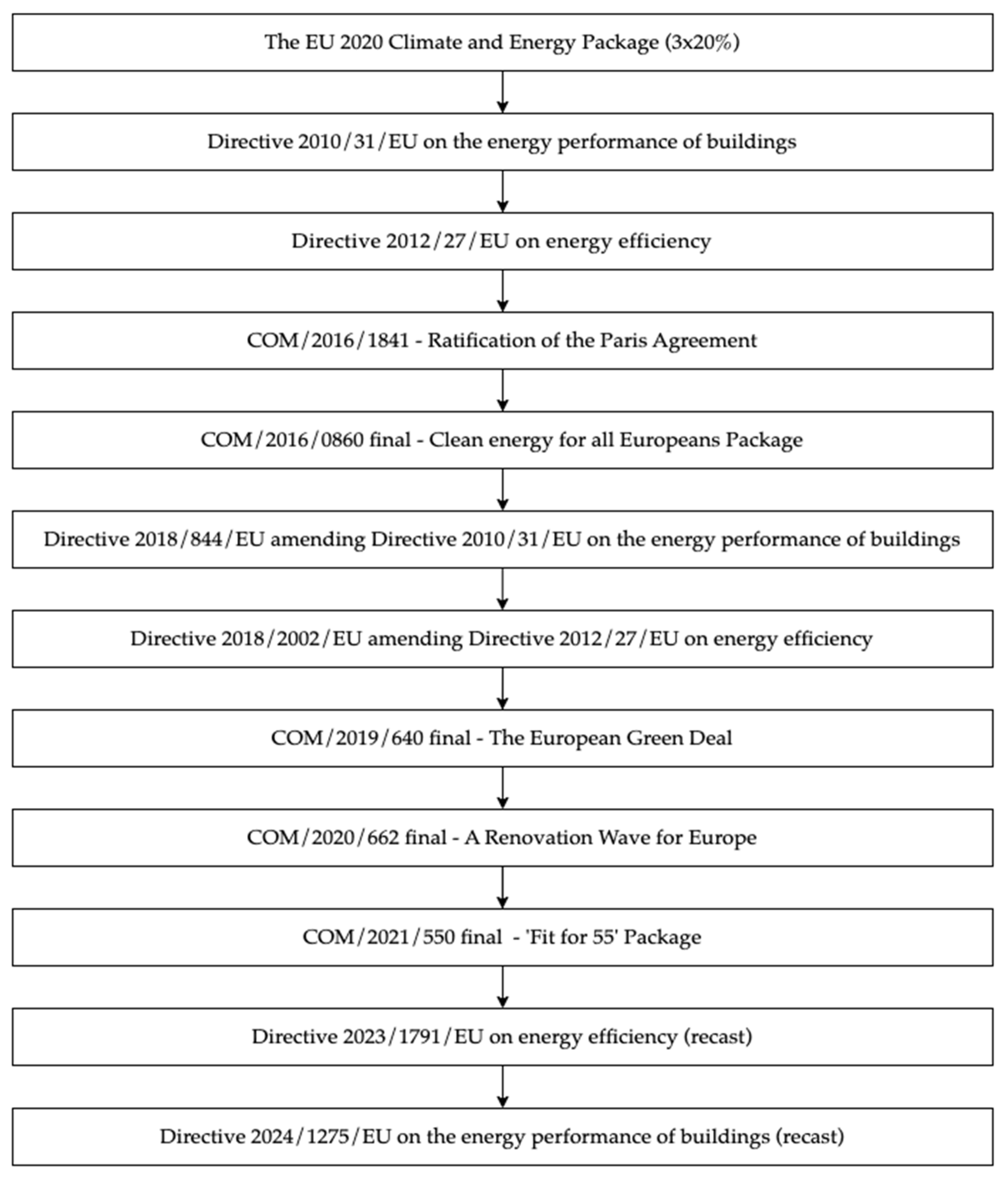
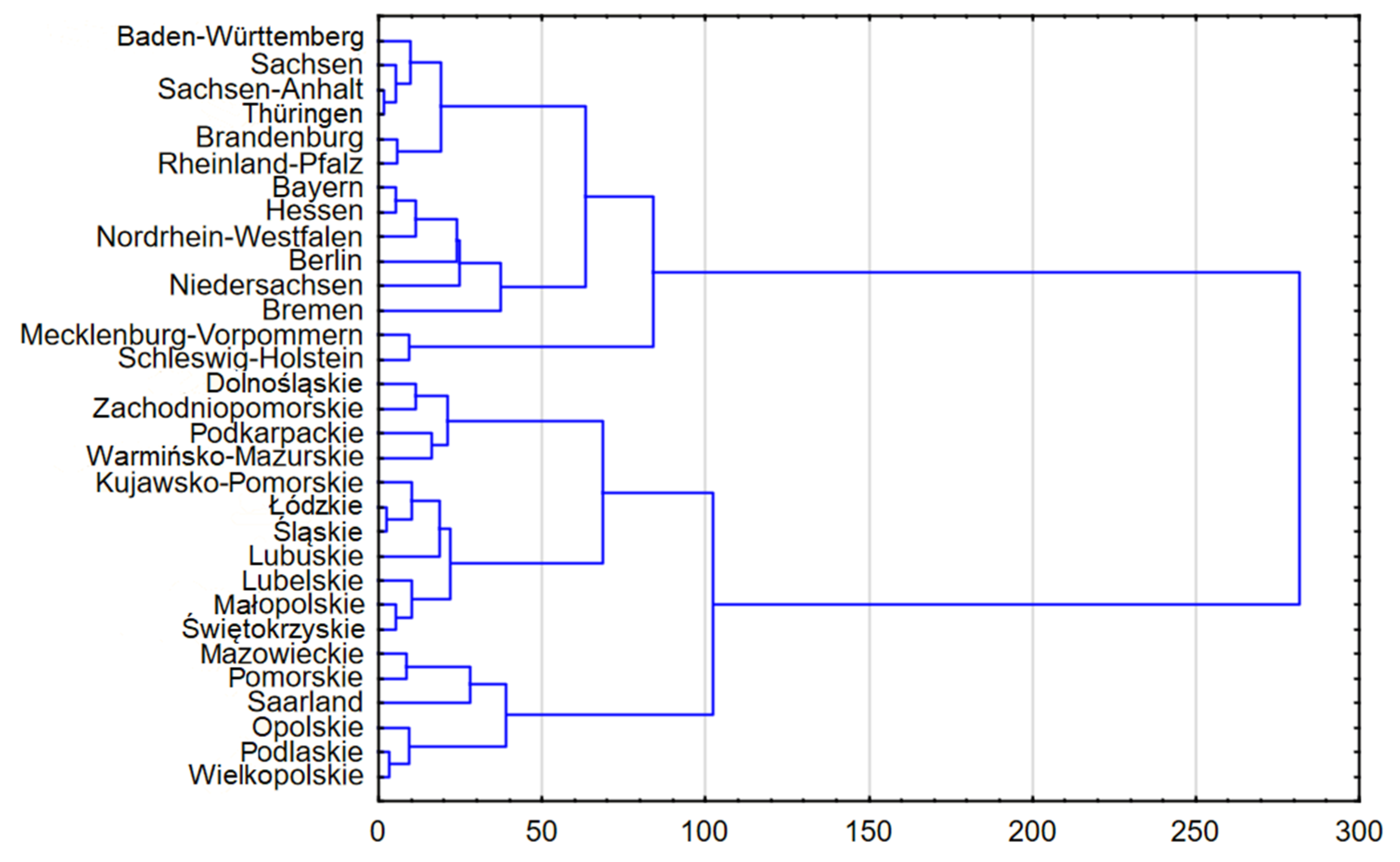
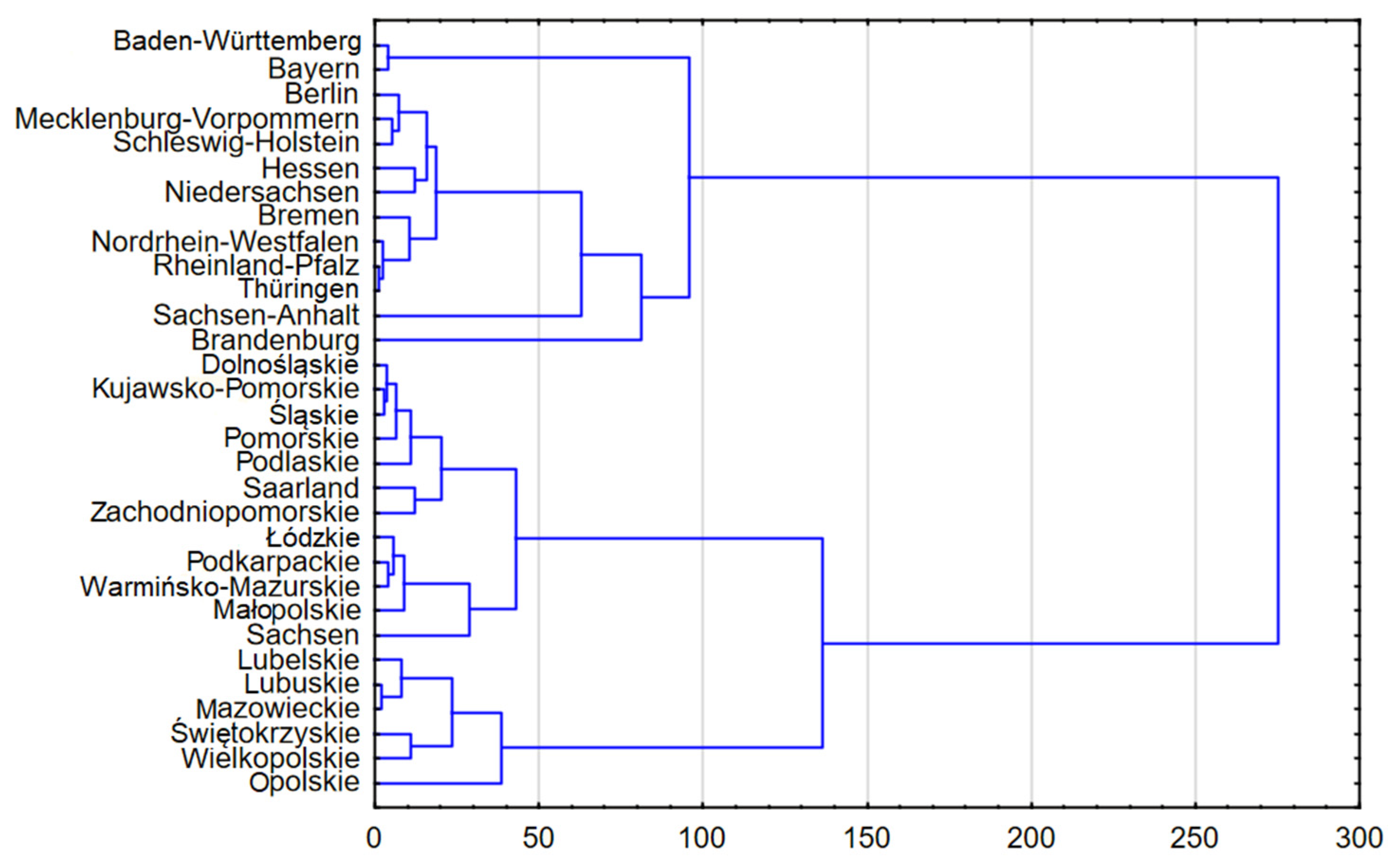

| Beneficiary | Investment |
|---|---|
| SGU—self-government unit | T—thermo-modernization, including the insulation of envelopes, the replacement of windows and door frames, and the installation of measurement systems |
| R&HC—residential and housing community | T+R—thermo-modernization combined with the installation or replacement of energy and/or heat sources based on RES |
| PHC—public health service | T+L—thermo-modernization combined with the replacement of lighting to energy-efficient solutions |
| NGO—non-governmental organization | T+R+L—thermo-modernization combined with investments in RES and energy-efficient lighting |
| PES—private enterprise sector | R—investment in RES, such as photovoltaics, solar thermal collectors, heat pumps |
| FI—financial institution | DB—energy-efficient and passive building, including demonstration building |
| RI—religious institution | FIS—financial instrument, such as program, subsidy, or grant on IEEBs |
| OB—other beneficiary, e.g., public administration, universities, police, and fire departments | OI—other investment, such as the replacement of heat sources based on fossil fuels (e.g., gas or coal furnaces), the connection to a district heating network, the replacement of machinery, the replacement or installation of HVAC systems, or energy audits |
Disclaimer/Publisher’s Note: The statements, opinions and data contained in all publications are solely those of the individual author(s) and contributor(s) and not of MDPI and/or the editor(s). MDPI and/or the editor(s) disclaim responsibility for any injury to people or property resulting from any ideas, methods, instructions or products referred to in the content. |
© 2024 by the authors. Licensee MDPI, Basel, Switzerland. This article is an open access article distributed under the terms and conditions of the Creative Commons Attribution (CC BY) license (https://creativecommons.org/licenses/by/4.0/).
Share and Cite
Kociuba, D.; Janczak, M. Effects of the Disbursement of EU Cohesion Policy 2014–2020 Funds on Improving the Energy Efficiency of Buildings in Poland and Germany. Energies 2024, 17, 4417. https://doi.org/10.3390/en17174417
Kociuba D, Janczak M. Effects of the Disbursement of EU Cohesion Policy 2014–2020 Funds on Improving the Energy Efficiency of Buildings in Poland and Germany. Energies. 2024; 17(17):4417. https://doi.org/10.3390/en17174417
Chicago/Turabian StyleKociuba, Dagmara, and Maciej Janczak. 2024. "Effects of the Disbursement of EU Cohesion Policy 2014–2020 Funds on Improving the Energy Efficiency of Buildings in Poland and Germany" Energies 17, no. 17: 4417. https://doi.org/10.3390/en17174417
APA StyleKociuba, D., & Janczak, M. (2024). Effects of the Disbursement of EU Cohesion Policy 2014–2020 Funds on Improving the Energy Efficiency of Buildings in Poland and Germany. Energies, 17(17), 4417. https://doi.org/10.3390/en17174417






